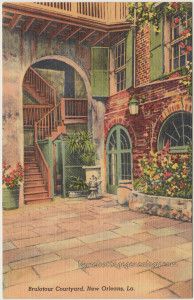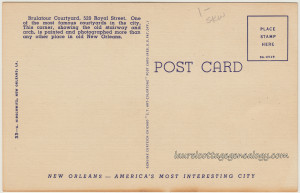Divided back, linen, unused postcard. Genuine Curteich – Chicago, “C. T. Art – Colortone” (Registered at the U.S. Patent Office) Publisher: A. Hirschwitz, New Orleans, LA. Series 33. Stamp box shows “Place Stamp Here” and Curteich series “SA-H829.” Circa 1931 – 1945
Price: $10.00
“Brulatour Courtyard, 520 Royal Street. One of the most famous courtyards in the city. This corner, showing the old stairway and arch, is painted and photographed more than any other place in old New Orleans.”
This posting is one of many that finds the researcher veering off in multiple, often surprising directions. In this case some of the subjects coming into the spotlight are film, furniture, wine, maritime disasters, and artists. One subject always leads to the next, and of course, this happily meandering path could go on indefinitely.
WINE, FILM AND MARITIME
The courtyard gets it’s name from Pierre Ernest (or Ernest Pierre, city directory records show both) Brulatour, born about 1802, who came to New Orleans at about age 34, according to an online immigration record. He was a wine merchant in New Orleans, having lived for a time at the Royal Street address on the postcard, and was the paternal grandfather of Pierre Ernest Jules Brulatour (1870 – 1946.) The younger Brulatour is said to have been named after the grandfather. (Possibly they both had the same exact name but that question will not be looked into here.) Much has been written about Jules Brulatour, the grandson, who was a very successful pioneering figure in the early American film industry. An interesting fact about Jules’ second wife, Dorothy Gibson, is that not only was she a survivor of the Titanic disaster, but she played herself (prior to her marriage to Jules) in Saved From the Titanic, the first movie ever made about the maritime tragedy. Logically, the film’s producer was Jules Brulatour.
FURNITURE AND WINE
The building depicted here is said to have been built in 1816 and first occupied by François Seignouret, a fine furniture maker and wine merchant, born 1783 in Bordeaux, France. Seignouret’s furniture is famous for it’s elegant lines and is highly sought-after, and the wine business that he founded in 1830 is still in operation today, as Seignouret Frères & Cie.
ARTISTS
520 Royal Street was also, at one time, home to the Arts and Crafts Club of New Orleans, a group of artists that organized to form the club, and are recognized as a major force in starting the movement to preserve the historic French Quarter. They had moved in to the building in December of 1921. The club incorporated in 1922 and ran till 1951, and though they only headquartered at the 520 Royal address for a short number of years, they are nevertheless, an important part of its history.
CURRENT PLANS
The building and courtyard are owned today by The Historic New Orleans Collection, who are currently working to turn the site into a historical museum, with a vision that includes the site as a venue for music and art. The site excavators have made a fascinating discovery of a 200 year-old well.
MORE POSTCARD PUBLISHER INFO
From time to time questions arise regarding the publisher information given on postcards, such as: Is the printed name appearing on the postcard that of the publisher? (Sometimes it seems a bit unclear.) Or really, who is this guy – is he the publisher, and by the way, what does a postcard publisher really do? Well, it’s only logical then to create a separate category for publishers, and that will be forthcoming. In searching for some clarification for this post, we find that A. Hirschwitz was Aaron Hirschwitz, born in Louisiana, about 1874, according to the 1930 Federal Census, for New Orleans. He is listed there with wife Sadie, daughter Thelma Sarpy, grandson Aaron Sarpy, and boarder Simon Geismar. The Hirschwitz home address on this census is 1937 Peniston St., and Aaron Hirschwitz is stated as home owner, with occupation given as “President” in the industry of “Souvenirs.”
Sources: http://www.steinerag.com/flw/Artifact%20Pages/Postcards.htm (re Curteich)
Ancestry.com. U.S. and Canada, Passenger and Immigration Lists Index, 1500s-1900s [database on-line]. Provo, UT, USA: Ancestry.com Operations, Inc, 2010.Original data: Filby, P. William, ed. Passenger and Immigration Lists Index, 1500s-1900s. Farmington Hills, MI, USA: Gale Research, 2012.
Hemard, Ned. “Jules Brulatour.” In KnowLA Encyclopedia of Louisiana, edited by David Johnson. Louisiana Endowment for the Humanities, 2010–. Article published August 26, 2013. http://www.knowla.org/entry/1616/.
http://www.seignouret.com/en/index.html
Bonner, Judith H. “Arts and Crafts Club of New Orleans.” In KnowLA Encyclopedia of Louisiana, edited by David Johnson. Louisiana Endowment for the Humanities, 2010–. Article published January 3, 2011. http://www.knowla.org/entry/474/.
http://nola.curbed.com/tags/brulatour-house-and-courtyard
Year: 1930; Census Place: New Orleans, Orleans, Louisiana; Roll: 809; Page: 21B; Enumeration District: 0200; Image: 971.0; FHL microfilm: 2340544. Ancestry.com. 1930 United States Federal Census [database on-line]. Provo, UT, USA: Ancestry.com Operations Inc, 2002. Original data: United States of America, Bureau of the Census. Fifteenth Census of the United States, 1930. Washington, D.C.: National Archives and Records Administration, 1930. T626, 2,667 rolls.


